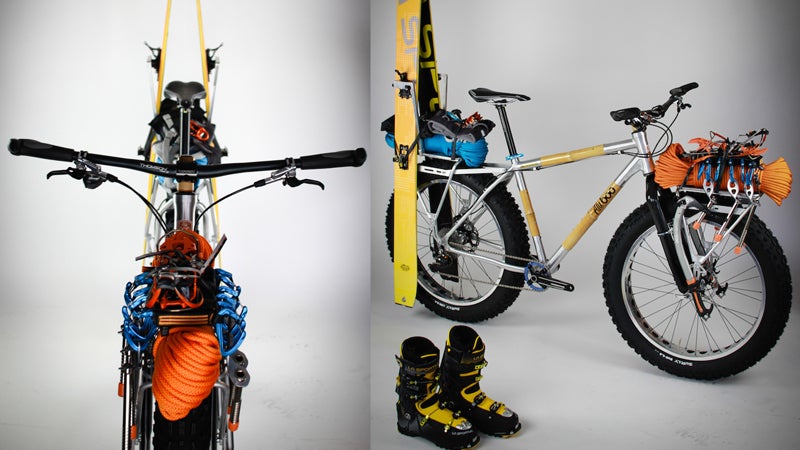One of the most interesting trends to watch in the next few years will be how ski resorts respond to fat bikers. As the giant-tired bikes steamroll toward the mainstream, they present a new demographic for landowners. There has already been antagonism, with some skiers asserting that fat bikes damage trails and have no place at resorts.
So it’s refreshing to see a move, albeit extremely niche, toward coexistence. This winter, —the Colorado-based manufacturer of bamboo bikes—unveiled a one-off fat bike customized for ski mountaineering. Released under the company’s mark, which sells complete bikes built around aluminum-bamboo frames for significantly less money than the pricey Boo line, the bike is a veritable pedal-powered snowmobile.
The (it’s worth considering, based on the name alone) is the company’s stock fat bike, which retails at $895 for the frame set. This particular model, however, is equipped with custom-built that accommodate a full ice-climbing setup, including tools, crampons, two half ropes, and ice screws. It’s also stocked with custom ski mounts, designed and machined in-house, which fit most standard pannier-style racks and fold out of the way when not in use. The mounts hold skis up to 125mm wide underfoot. The mounted skis also double as a stand system to prop up the bike for loading and unloading. Both racks and ski mounts are of brushed aluminum, to match the frame, and the company hopes to offer the ski rack next fall as an optional accessory for its bikes.Â
The SkiMo Alubooyah, as we’ll call it, is the brainchild of Jacob Lapenna, the chief technical officer at Boo. A few years ago, while ascending central Colorado’s 14,275-foot Torrey’s Peak, Lapenna spied a 75-degree ice couloir that he wanted to return to and climb. Getting to the base of the climb would be a slog, including four miles of packed snowmobile track and a mile of hip-deep powder. And while Lapenna acknowledges that he could ski the entire way in, a bike might be quicker, and would take the weight off his back for a considerable portion of the approach.Â
“Mostly it was just for fun, though,” he says. “I’ve fat biked that trail before, and had a great time doing it. So this allowed us not only to string together a bunch of different sports, but also to showcase what we can do as a bike manufacturer.” He adds: “There’s lots of ice in Colorado that’s way back in there, perfect for a bike like this.”
As for the idea of skier-biker clashes, Lapenna shrugs it off. “Where I’m planning on taking this bike, it’s all deep in the backcountry, so I don’t think there’s any fear of conflict,” he says. “Besides, whatever gets more people out on the trails, caring about the trails, donating money for the trails—that can’t be a bad thing.”


